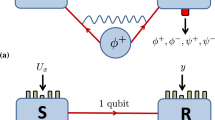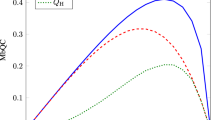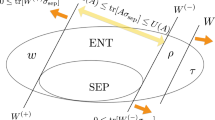Abstract
Coherent interactions that generate negligible entanglement can still exhibit unique quantum behaviour. This observation has motivated a search beyond entanglement for a complete description of all quantum correlations. Quantum discord is a promising candidate. Here, we demonstrate that under certain measurement constraints, discord between bipartite systems can be consumed to encode information that can only be accessed by coherent quantum interactions. The inability to access this information by any other means allows us to use discord to directly quantify this ‘quantum advantage’. We experimentally encode information within the discordant correlations of two separable Gaussian states. The amount of extra information recovered by coherent interaction is quantified and directly linked with the discord consumed during encoding. No entanglement exists at any point of this experiment. Thus we introduce and demonstrate an operational method to use discord as a physical resource.
This is a preview of subscription content, access via your institution
Access options
Subscribe to this journal
Receive 12 print issues and online access
$209.00 per year
only $17.42 per issue
Buy this article
- Purchase on Springer Link
- Instant access to full article PDF
Prices may be subject to local taxes which are calculated during checkout



Similar content being viewed by others
References
Bennett, C. H. & Wiesner, S. J. Communication via one- and two-particle operators on Einstein–Podolsky–Rosen states. Phys. Rev. Lett. 69, 2881–2884 (1992).
Shor, P. W. Polynomial-time algorithms for prime factorization and discrete logarithms on a quantum computer. SIAM J. Comput. 26, 1484–1509 (1997).
Ekert, A. K. Quantum cryptography based on Bell’s theorem. Phys. Rev. Lett. 67, 661–663 (1991).
Grover, L. K. Quantum Mechanics helps in searching for a needle in a haystack. Phys. Rev. Lett. 79, 325–328 (1997).
Bennett, C. H. & Brassard, G. Proc. IEEE Int. Conf. on Computers, Systems and Signal Processing 175–179 (IEEE, 1984).
Knill, E. & Laflamme, R. Power of one bit of quantum information. Phys. Rev. Lett. 81, 5672–5675 (1998).
Datta, A. & Vidal, G. Role of entanglement and correlations in mixed-state quantum computation. Phys. Rev. A 75, 042310 (2007).
Datta, A., Shaji, A. & Caves, C. M. Quantum discord and the power of one qubit. Phys. Rev. Lett. 100, 050502 (2008).
Lanyon, B. P., Barbieri, M., Almeida, M. P. & White, A. G. Experimental quantum computing without entanglement. Phys. Rev. Lett. 101, 200501 (2008).
Bennett, C. H. et al. Quantum nonlocality without entanglement. Phys. Rev. A 59, 1070–1091 (1999).
Henderson, L. & Vedral, V. Classical, quantum and total correlations. J. Phys. A 34, 6899–6905 (2001).
Ollivier, H. & Zurek, W. H. Quantum discord: A measure of the quantumness of correlations. Phys. Rev. Lett. 88, 017901 (2001).
Laflamme, R., Cory, D. G., Negrevergne, C. & Viola, L. NMR quantum information processing and entanglement. Quant. Inf. Comput. 2, 166–176 (2002).
Vedral, V. The elusive source of quantum speedup. Found. Phys. 40, 1141–1154 (2010).
Rodríguez-Rosario, C. A., Modi, K., Kuah, A.-M., Shaji, A. & Sudarshan, E. C. G. Completely positive maps and classical correlations. J. Phys. A 41, 205301 (2008).
Piani, M., Horodecki, P. & Horodecki, R. No-local-broadcasting theorem for quantum correlations. Phys. Rev. Lett. 100, 090502 (2008).
Luo, S. & Sun, W. Decomposition of bipartite states with applications to quantum no-broadcasting theorems. Phys. Rev. A 82, 012338 (2010).
Tomasello, B., Rossini, D., Hamma, A. & Amico, L. Symmetry breaking and correlations in a quantum many body system. Europhys. Lett. 96, 27002 (2011).
Giorda, P. & Paris, M. G. A. Gaussian quantum discord. Phys. Rev. Lett. 105, 020503 (2010).
Adesso, G. & Datta, A. Quantum versus classical correlations in Gaussian states. Phys. Rev. Lett. 105, 030501 (2010).
Oppenheim, J., Horodecki, M., Horodecki, P. & Horodecki, R. A thermodynamical approach to quantifying quantum correlations. Phys. Rev. Lett. 89, 180402 (2002).
Zurek, W. H. Quantum discord and Maxwell’s demons. Phys. Rev. A 67, 012320 (2003).
Brodutch, A. & Terno, D. R. Quantum discord and local demons. Phys. Rev. A 81, 062103 (2010).
Datta, A. & Gharibian, S. Signatures of non-classicality in mixed-state quantum computation. Phys. Rev. A 79, 042325 (2009).
Boixo, S., Aolita, L., Cavalcanti, D., Modi, K. & Winter, A. Quantum locking of classical correlations and quantum discord of classical-quantum states. IJQI 9, 1643–1651 (2011).
Cavalcanti, D. et al. Operational interpretations of quantum discord. Phys. Rev. A 83, 032324 (2011).
Madhok, V. & Datta, A. Interpreting quantum discord through quantum state merging. Phys. Rev. A 83, 032323 (2011).
Madhok, V. & Datta, A. Lecture Notes in Computer Science (Springer, 2011).
Braunstein, S. L., Cerf, N. J., Iblisdir, S., van Loock, P. & Massar, S. Optimal cloning of coherent states with a linear amplifier and beam splitters. Phys. Rev. Lett. 86, 4938–4941 (2001).
Fiurášek, J. Optical implementation of continuous-variable quantum cloning machines. Phys. Rev. Lett. 86, 4942–4945 (2001).
Weedbrook, C. et al. Gaussian quantum information. Rev. Mod. Phys. 84, 621–669.
Schumacher, B. & Westmoreland, M. D. Quantum mutual information and the one-time pad. Phys. Rev. A 74, 042305 (2006).
Acknowledgements
We thank C. Weedbrook, J. Thompson, N. Walk and H. Wiseman for helpful discussions. The research is supported by the National Research Foundation and Ministry of Education in Singapore (M.G., K.M. and V.V.), the John Templeton Foundation (K.M. and V.V.), and the Australian Research Council Centre of Excellence for Quantum Computation and Communication Technology (Project number CE110001027). (H.C., S.M.A., T.S., T.C.R. and P.K.L.).
Author information
Authors and Affiliations
Contributions
M.G. V.V. and T.C.R. conceived the idea. M.G. and K.M. formalized the theory. P.K.L., M.G., T.S., S.M.A. and H.M.C. conceived the experiment. H.M.C. and S.M.A. conducted the experiment and analysed the data. S.M.A. and H.M.C. developed the experimental model. M.G., H.M.C, T.S. and S.M.A. drafted the manuscript. P.K.L, T.S. and V.V. planned and supervised the project. All authors discussed the results and commented on the manuscript at all stages.
Corresponding authors
Ethics declarations
Competing interests
The authors declare no competing financial interests.
Supplementary information
Supplementary Information
Supplementary Information (PDF 257 kb)
Rights and permissions
About this article
Cite this article
Gu, M., Chrzanowski, H., Assad, S. et al. Observing the operational significance of discord consumption. Nature Phys 8, 671–675 (2012). https://doi.org/10.1038/nphys2376
Received:
Accepted:
Published:
Issue Date:
DOI: https://doi.org/10.1038/nphys2376
This article is cited by
-
Temporal evolution of quantum correlations under non-Hermitian operation
Optical and Quantum Electronics (2022)
-
Geometric quantum discords under Hierarchical-environment with filtering operator
Quantum Information Processing (2021)
-
Nonlocal correlations and noise in different settings of a two-player game
Quantum Information Processing (2020)
-
Asymmetric quantum correlations in the dynamical Casimir effect
Scientific Reports (2019)
-
Secure quantum remote state preparation of squeezed microwave states
Nature Communications (2019)



